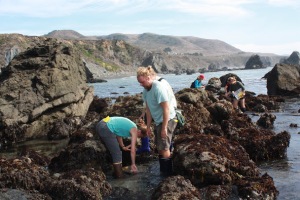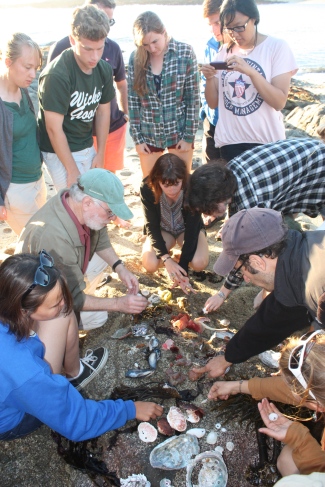Post by Katrina Orthmann, Williams-Mystic Class of Fall 2017 (University of Minnesota ’19)
Photography by Jesse Edwards and Haley Kardek (Williams-Mystic F’17)

- Climbing aloft on a tall ship.
Our 10-day Offshore Field Seminar was incredible – like something out of a pirate movie, but with less violence. One of the coolest experiences was climbing aloft to the top of the mast. The adrenaline of being a hundred feet in the air and the simultaneous serenity of looking out across the crinkled surface of the open water is a feeling like no other.

- Spending a night waltzing at a Cajun dance hall.
We spent one evening in Houma, Louisiana at the Jolly Inn, a traditional Cajun dance hall. Our history professor, Glenn, is a fantastic dancer and taught us the Cajun two-step and a basic waltz step. I’ve never considered myself a very good dancer—at age three I took a dance class that consisted of me lying on the floor while the other tutu-clad girls danced around me—but that night was one of my favorite experiences.

- Learning to shipsmith.
Some of my classmates took shipsmithing as their maritime skill for the semester, which is insanely cool—or rather incredibly hot, since you’re working in a forge. My friend Alissa told me that wielding the hammer is difficult, but that it’s satisfying to graduate to a bigger hammer. The instructor, Bill, reportedly knows when you’re ready. “It’s time,” he’ll say, and your arm will ache, but you’ll come away with metal hooks, bottle openers, and bicep muscles galore.
- Kayaking down the Mystic River to look for fiddler crabs for your science project.
So many awesome science projects were done this semester, one of which was a survey of fiddler crabs in the area. They haven’t been found in the area until recently, so the study was very interesting. Plus, who doesn’t want an excuse to kayak down the river on a beautiful day? Just make sure to bring your foul weather gear… the mud in the Mystic River is no joke!
- Learning to sail a small boat by yourself.
I came into the program intending to learn how to sail, so I chose the basic watercraft skills class as my maritime skill. The weather this semester was perfect for sailing; being out on the water on a crisp fall afternoon, with a light breeze blowing and the sun warming your face, is amazing. I even finished the semester with an award: the first (and only) person in the class to capsize! I’d like to re-emphasize that the mud in the Mystic River is no joke.
- Seeing the program director dressed up as Moby Dick, the infamous white whale, on the morning your paper is due.
I vividly remember standing in the kitchen around 8:30 in the morning, making coffee, enjoying the peaceful silence and getting ready to turn in my Moby-Dick paper, and suddenly there was a loud pounding on the door. A blur of white moved past the window as I flung the door open, and I saw this giant… whale-type… thing… sprinting across the yard. It was Tom Van Winkle himself (our Executive Director) dressed as the white whale!
- Helping reconstruct the Mayflower II in the shipyard.
My roommate, Monica, worked in the shipyard for her student job, and she got to help reconstruct the Mayflower II, a replica of the 17th-century ship Mayflower. What a cool thing, to have helped restore a tall ship!
- Singing sea chanteys aboard the Charles W. Morgan, the world’s last remaining wooden whaling ship.
Another maritime skill some of my classmates took was Chantey-Singing. My friend Kyra and I were both in sailing, but we stopped by chanteys to sing a few times, sometimes aboard the Charles W. Morgan. We learned some great chanteys, which led to the creation of a chantey playlist on Spotify and more than a few chantey karaoke sessions.
- Listening to a lecture backed by the sound of waves in California.
One of the best things about the field seminars was that we got to have lectures in places we learned about. While in California, we learned about John Steinbeck’s Cannery Row at the actual Cannery Row and about shipping in the San Francisco Bay while we sat overlooking the Golden Gate Bridge. We discussed the ecology of the intertidal at Point Lobos as we watched the waves crash into rocky cliffs below ; we talked about the marine policy at Pescadero Beach while the sun set in the background.
- Learning traditional sailor skills in Squad.
Another maritime skill class some of my classmates did was Demonstration Squad, which actually involved multiple skills. They did everything from rowing a whaleboat to climbing aloft on tall ships to skinning a cod (which they then made into a stew for dinner that night). They also performed a rescue drill called Breeches Buoy, so called because of the pair of breeches used as a “buoy” to rescue people from shipwrecks. It was so fun to watch, and looked even more fun to perform!
- Sifting through primary documents for your history research paper.
The Collections Research Center at the Seaport contains millions of primary documents from sailors and ships throughout maritime history, many of which can’t be found anywhere else. In the process of doing research for our history projects, we’ve come across some firsthand accounts of life at sea and of historical events. It’s so cool to have all this and more at our fingertips.
- Spending the semester surrounded by a small group of amazing classmates and professors, immersed in this incredible program.
Williams-Mystic is truly one-of-a-kind. I stumbled across the program by coincidence and was on the fence about applying—I didn’t know if it was realistic or if it would be worth it. But if you’re reading this and trying to decide whether or not to apply, my advice to you is that it is so, so worth it. The people I’ve met here have become some of my best friends and all of the faculty and staff are so kind, caring, and passionate about what they do. I’ve learned so much about the maritime world and about myself. I’ve gotten so much out of this experience and I would encourage everyone to participate in a program this special.
















